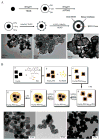Synthesis and Properties of Magnetic-Optical Core-Shell Nanoparticles
- PMID: 28603606
- PMCID: PMC5460537
- DOI: 10.1039/C7RA01224A
Synthesis and Properties of Magnetic-Optical Core-Shell Nanoparticles
Abstract
Due to their high integrity, facile surface chemistry, excellent stability, and dual properties from the core and shell materials, magnetic-plasmonic core-shell nanoparticles are of great interest across a number of science, engineering and biomedical disciplines. They are promising for applications in a broad range of areas including catalysis, energy conversion, biological separation, medical imaging, disease detection and treatment. The technological applications have driven the need for high quality nanoparticles with well controlled magnetic and optical properties. Tremendous progress has been made during past few decades in synthesizing and characterizing magnetic-plasmonic core-shell nanoparticles, mainly iron oxide-gold core-shell nanoparticles. This review introduces various approaches for the synthesis of spherical and anisotropic magnetic-plasmonic core-shell nanoparticles focusing on iron oxide-gold core-shell nanoparticles. Growth mechanisms are discussed to provide understanding of the key factors controlling shape-controlled synthesis. Magnetic and optical properties are summarized from both computational and experimental studies.
Keywords: Synthesis; core-shell nanoparticles; gold; iron oxide; magnetic-plasmonic; optical properties.
Figures








Similar articles
-
Size- and Shape-Controlled Synthesis and Properties of Magnetic-Plasmonic Core-Shell Nanoparticles.J Phys Chem C Nanomater Interfaces. 2016 May 19;120(19):10530-10546. doi: 10.1021/acs.jpcc.6b00875. Epub 2016 Apr 27. J Phys Chem C Nanomater Interfaces. 2016. PMID: 27239246 Free PMC article.
-
Magnetic-Plasmonic Core-Shell Nanoparticles: Properties, Synthesis and Applications for Cancer Detection and Treatment.Nanomaterials (Basel). 2025 Feb 10;15(4):264. doi: 10.3390/nano15040264. Nanomaterials (Basel). 2025. PMID: 39997827 Free PMC article. Review.
-
Core-Shell-Heterostructured Magnetic-Plasmonic Nanoassemblies with Highly Retained Magnetic-Plasmonic Activities for Ultrasensitive Bioanalysis in Complex Matrix.Adv Sci (Weinh). 2019 Dec 13;7(2):1902433. doi: 10.1002/advs.201902433. eCollection 2020 Jan. Adv Sci (Weinh). 2019. PMID: 31993296 Free PMC article.
-
Recent Advances in the Use of Iron-Gold Hybrid Nanoparticles for Biomedical Applications.Nanomaterials (Basel). 2021 May 6;11(5):1227. doi: 10.3390/nano11051227. Nanomaterials (Basel). 2021. PMID: 34066549 Free PMC article. Review.
-
Precisely size-tunable magnetic/plasmonic core/shell nanoparticles with controlled optical properties.Angew Chem Int Ed Engl. 2015 Oct 5;54(41):12091-6. doi: 10.1002/anie.201504676. Epub 2015 Aug 31. Angew Chem Int Ed Engl. 2015. PMID: 26331483
Cited by
-
One Dimensional Coordination Polymer of Zn(II) for Developing Multifunctional Nanoparticles.Sci Rep. 2017 Oct 16;7(1):13212. doi: 10.1038/s41598-017-12980-6. Sci Rep. 2017. PMID: 29038429 Free PMC article.
-
Stimuli-Responsive Drug Delivery of Doxorubicin Using Magnetic Nanoparticle Conjugated Poly(ethylene glycol)-g-Chitosan Copolymer.Int J Mol Sci. 2021 Dec 6;22(23):13169. doi: 10.3390/ijms222313169. Int J Mol Sci. 2021. PMID: 34884973 Free PMC article.
-
Structure-Relaxivity Relationships of Magnetic Nanoparticles for Magnetic Resonance Imaging.Adv Mater. 2019 Feb;31(8):e1804567. doi: 10.1002/adma.201804567. Epub 2019 Jan 2. Adv Mater. 2019. PMID: 30600553 Free PMC article. Review.
-
Biosensors and Drug Delivery in Oncotheranostics Using Inorganic Synthetic and Biogenic Magnetic Nanoparticles.Biosensors (Basel). 2022 Sep 25;12(10):789. doi: 10.3390/bios12100789. Biosensors (Basel). 2022. PMID: 36290927 Free PMC article. Review.
-
Magnetic Nanoparticle-Mediated Heating for Biomedical Applications.J Heat Transfer. 2022 Mar;144(3):030801. doi: 10.1115/1.4053007. Epub 2022 Jan 18. J Heat Transfer. 2022. PMID: 35125512 Free PMC article.
References
-
- Kerker M. The scattering of light and other electromagnetic radiation. New York: Academic Press; 1969.
-
- Papavassiliou GC. Prog Solid State Chem. 1980;12:185.
-
- Bohren CF, Huffman DR. Absorption and scattering of light by small particles. New York: Wiley; 1983.
-
- Link S, El-Sayed MA. Ann Rev Phys Chem. 2003;54:331. - PubMed
-
- Link S, El-Sayed MA. Int Rev Phys Chem. 2000;19:409.
Grants and funding
LinkOut - more resources
Full Text Sources
Other Literature Sources
Miscellaneous
